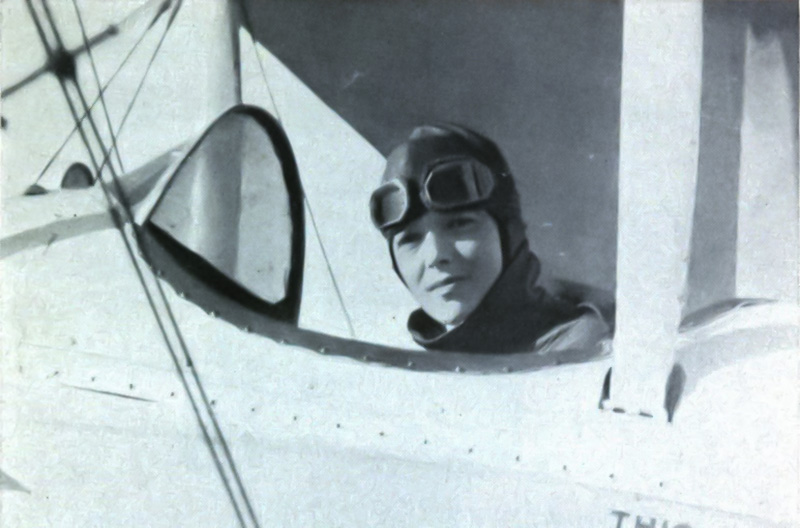Making History
Over the 20th century, there have been incredible moments that changed the world forever. Sometimes it feels like the world can be a dark place, but we so often forget that we've come so far.

WWII Comes To An End (1945)
WWII finally concluded on September 2, 1945. The Surrender Ceremony took place in Tokyo Bay aboard the US battleship Missouri, where General Douglas MacArthur accepted Japan's surrender.
 United States Navy, Wikimedia Commons
United States Navy, Wikimedia Commons
The First Organ Transplant (1954)
On December 23, 1954, Joseph Edward Murray performed an operation that would define his legacy—a human kidney transplant from one twin to the other. The patient who received the new kidney survived for another eight years following the surgery.
Murray went on to win the 1990 Nobel Prize.
Humans Walk On The Moon (1969)
On July 20, 1969, the Lunar Module Eagle reached the moon. Astronauts Neil Armstrong and Buzz Aldrin certainly made history, but Armstrong stepped out of the spacecraft first. As the first man to ever walk on the moon, he exclaimed, "That's one small step for man, one giant leap for mankind."
Around 650 million people watched this momentous achievement.
 Neil Armstrong, Wikimedia Commons
Neil Armstrong, Wikimedia Commons
The Fall Of The Berlin Wall (1989)
The destruction of the Berlin Wall began on November 9, 1989, after transit restrictions loosened and eventually fell by the wayside. This played a role in the eventual collapse of communism in Central and Eastern Europe.
The First Human In Space (1961)
On April 12, 1961, Yuri Gagarin from the Soviet Union traveled to space—the first person to ever accomplish such a feat.
Journeying in Vostok 1, Gagarin's flight lasted for 108 minutes. His speed? A jaw-dropping 27,4000 kilometers per hour. A computer navigated his reentry, with Gagarin eventually ejecting out of Vostok 1, and parachuting to safety.
 Mil.ru, CC BY 4.0, Wikimedia Commons
Mil.ru, CC BY 4.0, Wikimedia Commons
The Tuberculosis Vaccine (1921)
French scientists Albert Calmette and Camille Guérin invented the vaccine for tuberculosis—a terrible illness that ran rampant in the early 1900s and affected the lungs. First administered in 1921, the Bacillus Calmette-Guérin vaccine, or BCG, continues to be used today.
Around 100 million children are vaccinated annually.
 Unknown Author, CC BY 4.0, Wikimedia Commons
Unknown Author, CC BY 4.0, Wikimedia Commons
The Introduction Of Chemotherapy (1956)
In 1956, the drug methotrexate cured a patient with metastatic cancer for the first time, treating a kind of tumor known as choriocarcinoma. Chemotherapy works by inhibiting the ability of cells to grow and replicate, and has saved countless lives.
 Unknown Author, Wikimedia Commons
Unknown Author, Wikimedia Commons
Treatment For AIDS (1987)
In 1987, a drug called azidothymidine, or AZT, successfully treated the AIDS virus. The FDA had fast-tracked its production in a stunning amount of time—less than four months. Though it couldn't cure patients of the disease, it could block enzymes that allowed the virus to replicate.

History's most fascinating stories and darkest secrets, delivered to your inbox daily.
Women In The UK Are Granted The Right To Vote (1928)
The movement seeking the right to vote for women led to a pivotal moment in 1928 when the Conservative government passed the Representation of the People (Equal Franchise) Act. This meant that all people, both men and women, could vote if they were over the age of 21.
 Unknown Author, Wikimedia Commons
Unknown Author, Wikimedia Commons
The First Television Demonstration (1926)
On January 26, 1926, John Logie Baird demonstrated the very first live working television. Hailing from Scotland, Baird was an electrical engineer and inventor, who would one day present the color television system.
 Orrin Dunlap, Jr., Wikimedia Commons
Orrin Dunlap, Jr., Wikimedia Commons
The First Artificial Satellite (1957)
The very first artificial satellite, Sputnik I, was launched from the Soviet Union on October 4, 1957. Following an elliptical path, the small satellite orbited the Earth in just 98 minutes.
Contraceptive Pills (1960)
One of the most important advances in modern medicine was the invention of oral contraceptives, with the FDA officially approving the first one in 1960. Only two years after its release, around 1.2 million women in America were on the "pill."
The First Programmable Computer (1945)
Work on the ENIAC (Electronic Numerical Integrator and Computer) began in 1943—and finished in 1945. The physicist John Mauchly and engineer J. Presper Eckert collaborated with a team to complete this project for the American government.
ENIAC was the first programmable, general-purpose, electronic, digital computer.
 U.S. Army Photo, Wikimedia Commons
U.S. Army Photo, Wikimedia Commons
The First Baby Conceived By IVF (1978)
The very first person to be conceived by in vitro fertilization was Louise Joy Brown. Her birth on July 25, 1978 changed the world of medicine forever, and has been called one of "the most remarkable medical breakthroughs of the 20th Century."
The First Call On A Mobile Phone (1973)
The first company to manufacture a handheld mobile phone was Motorola. One of their executives and researchers, Martin Cooper, used the mobile phone for the first time on April 3, 1973. In an unforgettable power move, he decided to call his rival who worked for Bell Labs, Dr. Joel S. Engel.
This prototype was large, weighed 4.4 pounds, and became known as "the Brick."
 Rico Shen, CC BY-SA 3.0, Wikimedia Commons
Rico Shen, CC BY-SA 3.0, Wikimedia Commons
The First Black US President (2009)
From 2009 to 2017, Barack Obama served as the President of the United States. He was inaugurated on January 20, 2009, making him the very first Black president in American history.
 Pete Souza, CC BY 3.0, Wikimedia Commons
Pete Souza, CC BY 3.0, Wikimedia Commons
Martin Luther King's "I Have A Dream" Speech (1963)
On August 28, 1963, Martin Luther King Jr. delivered one of the most important speeches in history: "I Have a Dream." His voice rang out, calling for the end of racism, during the March on Washington for Jobs and Freedom.
For the civil rights movement, it was a pivotal and unforgettable moment.
The Creation Of The World Wide Web (1989)
While employed at CERN, British scientist Tim Berners-Lee created something in 1989 that turned the world upside-down—the World Wide Web (WWW). Without it, this article wouldn't exist.
The Release Of Nelson Mandela (1990)
Nelson Mandela spent 27 years behind bars for his treasonous opposition to the apartheid system in South Africa. He was finally released unconditionally on February 11, 1990.
Photographs Of Mars (1976)
The Viking mission had a clear goal in mind—to capture quality photographs of Mars's surface, collect information about the planet's atmosphere, makeup, and terrain, and investigate it for any evidence of life.
On July 20, 1976, the Viking 1 lander took the first photograph of the planet's surface.
Rosa Parks Refused To Give Up Her Seat (1955)
On December 1, 1955, Rosa Parks rode a bus in downtown Montgomery—but was asked to give up her seat in the Black section when the bus filled up, leaving some white folks standing. She refused to stand up and wound up being arrested.
In remembering that historical moment, she later stated, "When that white driver stepped back toward us, when he waved his hand and ordered us up and out of our seats, I felt a determination cover my body like a quilt on a winter night."
Rosa Parks's brave protest and arrest sparked the Montgomery bus boycott, which railed against racial segregation on public transit.
The First Email Goes Out (1971)
Ray Tomlinson was the computer programmer responsible for the first email program. In 1971, he sent the very first email—but it was a test message he didn't remember, confessing that it may have been something similar to "QWERTYUIOP."
Tomlinson said, "test messages were entirely forgettable and I have, therefore, forgotten them."
 Andreu Veà, CC BY-SA 3.0 Wikimedia Commons
Andreu Veà, CC BY-SA 3.0 Wikimedia Commons
Dolly The Sheep (1996)
In 1996, a sheep named Dolly became the first mammal to ever be cloned. She spent the rest of her life at her birthplace—the Roslin Institute in Scotland—and even gave birth to lambs. However, she eventually developed lung disease had had to be put down. She was only six years old.
Though Dolly was the first mammal ever cloned, she wasn't actually the first animal to be cloned. This title actually belongs to a tadpole, who was cloned in the 1950s.
The Jazz Singer (1927)
Sound films were a massive step forward from the silent film era. They were known as "talking pictures" or "talkies." On October 6, 1927, The Jazz Singer became the first feature film to premiere as a "talkie."
Amelia Earhart's Transatlantic Flight (1932)
On May 20, 1932, Amelia Earhart flew across the Atlantic Ocean by herself. She was the first woman to achieve this feat and the second person to do so, following Charles Lindbergh. Her aircraft was a Lockheed Vega 5B, and her trip from Newfoundland, Canada to Northern Ireland took around 15 hours.
 Amelia Earhart, Wikimedia Commons
Amelia Earhart, Wikimedia Commons
The First YouTube Video (2005)
The very first YouTube Video is titled "Me at the zoo." Uploaded on April 23, 2005, this 19-second video kicked off a platform that would change the internet forever.
In the video, 25-year-old Jawed Karim, one of YouTube's co-founders, can be seen visiting the elephants at the San Diego Zoo. Today, "Me at the Zoo" has over 328 million views.
The First MRI Scan (1977)
The magnetic resonance imaging scan (MRI) changed the world of medicine for the better, and has been saving lives since the first exam on a human patient in 1977. It allows doctors to see images of a patient's tissues, organs, and skeletal structures—and properly diagnose them.
 AndyGaskell, CC BY-SA 4.0, Wikimedia Commons
AndyGaskell, CC BY-SA 4.0, Wikimedia Commons
The Live Aid Concert (1985)
Live Aid occurred on July 13, 1985. It was a benefit concert that occurred on two stages: Wembley Stadium in London and JFK Stadium in Philadelphia. A jaw-dropping 1.5 billion people tuned in to watch the show on their televisions—and it helped raise millions of dollars for Ethiopia's horrific famine.
The First FIFA World Cup (1930)
In 1930, the very first FIFA World Cup took place in Uruguay, who hosted teams from 13 different countries. The tournament led to a final between Uruguay and Argentina, with Uruguay emerging as the winning team. Home field advantage?
 Unknown Author, Wikimedia Commons
Unknown Author, Wikimedia Commons
Invention Of The CD (1979)
A prototype compact disc (CD) was invented in 1979, but they weren't publicly released until 1982. They held about 80 minutes of audio and quickly became the most popular way to listen to music. Though online streaming services are more popular today, billions of CDs have been sold worldwide.
The First Use Of Penicillin (1941)
Albert Alexander was the first person to ever be given penicillin. However, he still met a tragic end.
Alexander had sustained a scratch on his mouth after a gardening mishap—but this small scratch turned into a horrifying infection, which affected his face, eyes, and lungs. Though he began to recover after receiving penicillin, Alexander passed only a few days later because there wasn't enough of the drug to treat him.
 Ministry of Information Photo Division Photographer, Wikimedia Commons
Ministry of Information Photo Division Photographer, Wikimedia Commons
The First Heart Transplant (1967)
When it comes to medical breakthroughs, the first heart transplant is certainly up there. In 1967, 55-year-old Louis Washkansky faced a dark diagnosis—severe heart failure. However, though he survived the very first human heart transplant, he perished from pneumonia 18 days after the operation. His donor was 25-year-old Denise Darvall, who had perished in a car accident, and his lead surgeon was Christiaan Barnard. Unknown Author, Wikimedia Commons
Unknown Author, Wikimedia Commons
The First Text Message (1992)
22-year-old Neil Papworth sent the very first SMS text message on December 3, 1992. His message read "Merry Christmas," and he sent it to a co-worker, using the Vodafone network.
The Invention Of GPS (1973)
The Global Positioning System (GPS) was invented in 1973. The man chiefly responsible for its creation was the American physicist Roger Lee Easton, who also worked with Ivan A. Getting and Bradford Parkinson.
Fun fact: GPS is still 100% owned and operated by the US military.
The First Blood Bank (1937)
The director of therapeutics at the Cook County Hospital in Chicago, Bernard Fantus, established the first blood bank in 1937. This set off a chain reaction, and soon blood banks began springing up all over America.
 Smithsonian Institution, Wikimedia Commons
Smithsonian Institution, Wikimedia Commons
The Discovery Of Insulin (1921)
On July 27, 1921, Canadian surgeon Dr. Frederick Banting and medical student Charles Best made an amazing discovery: They isolated the hormone insulin. This was a major breakthrough in the treatment of diabetes, and both Banting and Best went on to win a Nobel prize for their contributions to medicine.
 Unknown Author, Wikimedia Commons
Unknown Author, Wikimedia Commons




























